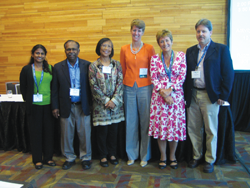Onward with Global Statistical Capacity

From left: Panelists Nilupa Gunaratna (organizer), Bovas Abraham, Juanita Tamayo Lott (chair), Sally Morton, Denise Lievesley, and Jim Cochran
In an interconnected world, collaborative and coherent institutional response to global phenomena is a 21st-century necessity. Such response is evident in crisis situations such as earthquakes in highly populated areas or disruptions of international airline travel.
Global statistical capacity building is the way in which statisticians can understand and constructively respond to global and local phenomena in real time and over time. JSM, with the help of ASA leadership, has acted as a catalyst for identifying and distilling the components of statistical capacity, particularly in ensuring evidence-based decisions and policymaking.
A basic component—education—was introduced at JSM 2008 with Louisiana Tech University Professor Jim Cochran’s presentation about an international education initiative to improve the quality of college-level quantitative education with five annual workshops (2007–2011) rotated across Latin America, Africa, and the Asia/Pacific regions.
At JSM 2009, Nilupa Gunaratna of the Nevin Scrimshaw International Nutrition Foundation focused on the diversity component by organizing an invited panel chaired by Steve Pierson, ASA director of science policy, and including diverse data collectors, analysts, and users: Cochran; Siobhan Carey of the Central Statistics Office, Ireland; Juanita Tamayo Lott of the U.S. Census Bureau; and Fritz Scheuren of the National Opinion Research Center.
Lively discussion between panelists and the audience elicited several themes. First, statistical capacity is multidimensional, developing and strengthening knowledge, skills, resources, infrastructure, institutional processes, and policy and legal frameworks at the individual, institutional, subnational, national, and international levels. Such capacity must be sustainable for gathering, maintaining, and using data for evidence-based decisionmaking and policymaking.
Global statistical capacity building is the way in which statisticians can understand and constructively respond to global and local phenomena …
Second, capacity building is a participatory/collaborative process. Listening, continuing engagement, and partnership are important.
Third, one size does not fit all. Different countries have different needs (e.g., big vs. small). All countries must continuously adapt to new challenges. Cultural differences exist, but some universal elements also exist (e.g., Education systems are different throughout the world, but there are similarities in how students learn.).
Fourth, lessons can be learned from success stories. That is, don’t reinvent the wheel. For example, the U.S. Census Bureau website provides access to a variety of demographic, economic, and geographic data developed and tested over decades with various stakeholders, including the government; private, nonprofit, and university sectors; and the public. This is free and accessible.
Fifth, effective global capacity occurs with organic leadership from the grassroots—the people who are affected by the data. Leadership and the contribution of individuals are important. Some capacity-building efforts are less successful when donors/agencies “dictate” what the goals and priorities are.
JSM 2010 focused on the role of statistical societies represented by Denise Lievesley, past president of the Royal Statistical Society and International Statistical Institute; Bovas Abraham, past president of the Statistical Society of Canada; Sally Morton, past president of the American Statistical Association; and Jim Cochran, co-chair of Statistics Without Borders (SWB). Global statistical capacity was a priority for all the societies and required the integration of statistics across users and producers, educators and employers, and practitioners and theoreticians. In addition to seeking complementary roles, societies could increase influence by working together and challenging bad practices. Given stagnant economies worldwide, creative new sources of funding are necessary. So also is balancing capacity building in the poorer countries while ensuring and safeguarding statistical integrity in richer nations.
In summary, global statistical capacity will become more imperative in the global village. The near future for global statistical capacity with JSM and the ASA includes the following:
- JSM 2011 session on effective global statistical capacity with organic leadership. In a time of frugal resources, what can we learn from nimble nonprofits with great track records, solid return on investment, and real outcomes for statistical capacity to complement national and institutional roles? Such capacity includes the increasing impact of global and local social networks in real time to collect, understand, synthesize, and use data for decisionmaking, from programmatic to policy levels.
- Continuing dialog and collaboration with statistical societies to advance global statistical capacity (e.g., via the International Statistical Institute Congress)
- A set of papers based on, but not limited to, JSM presentations

















